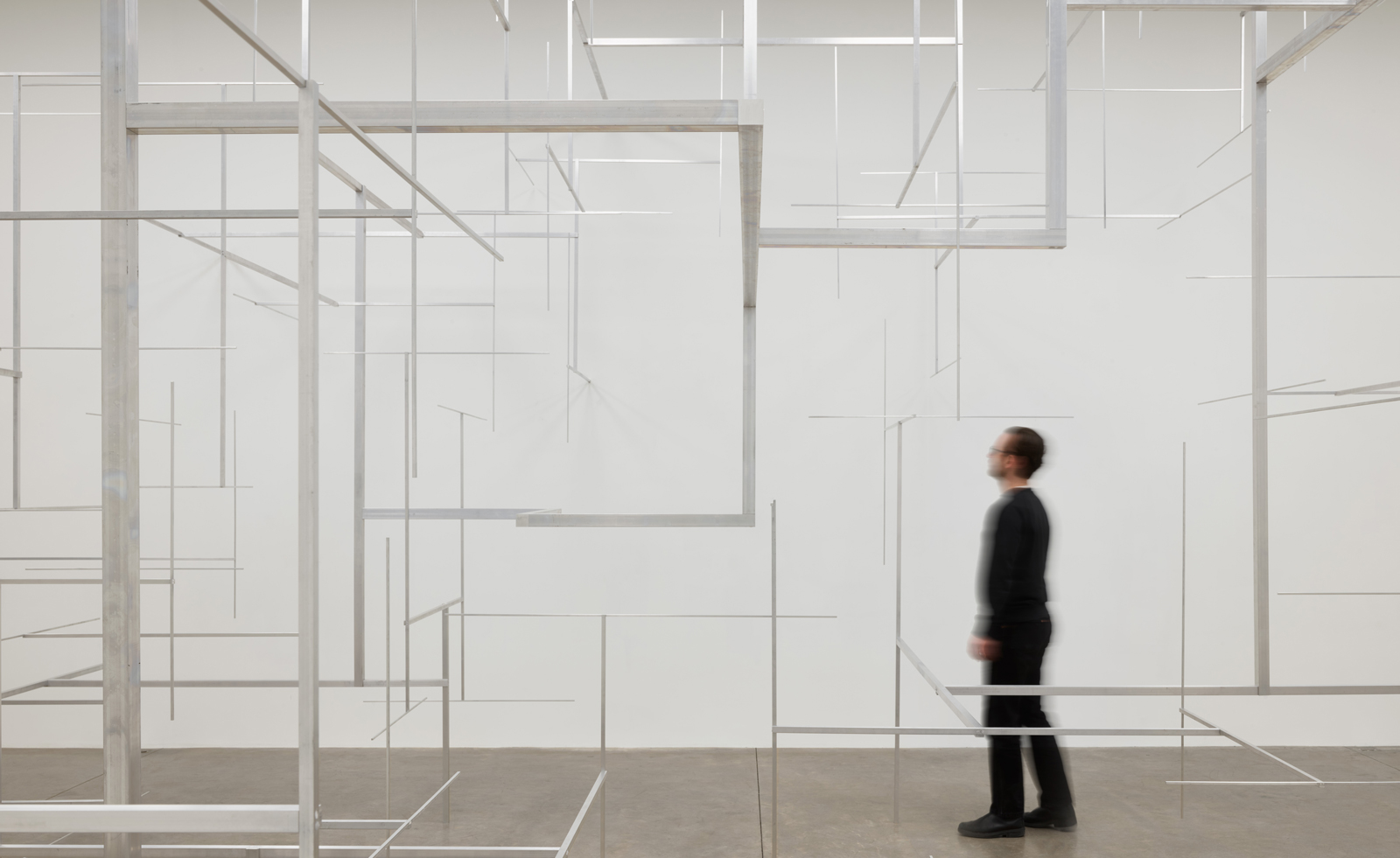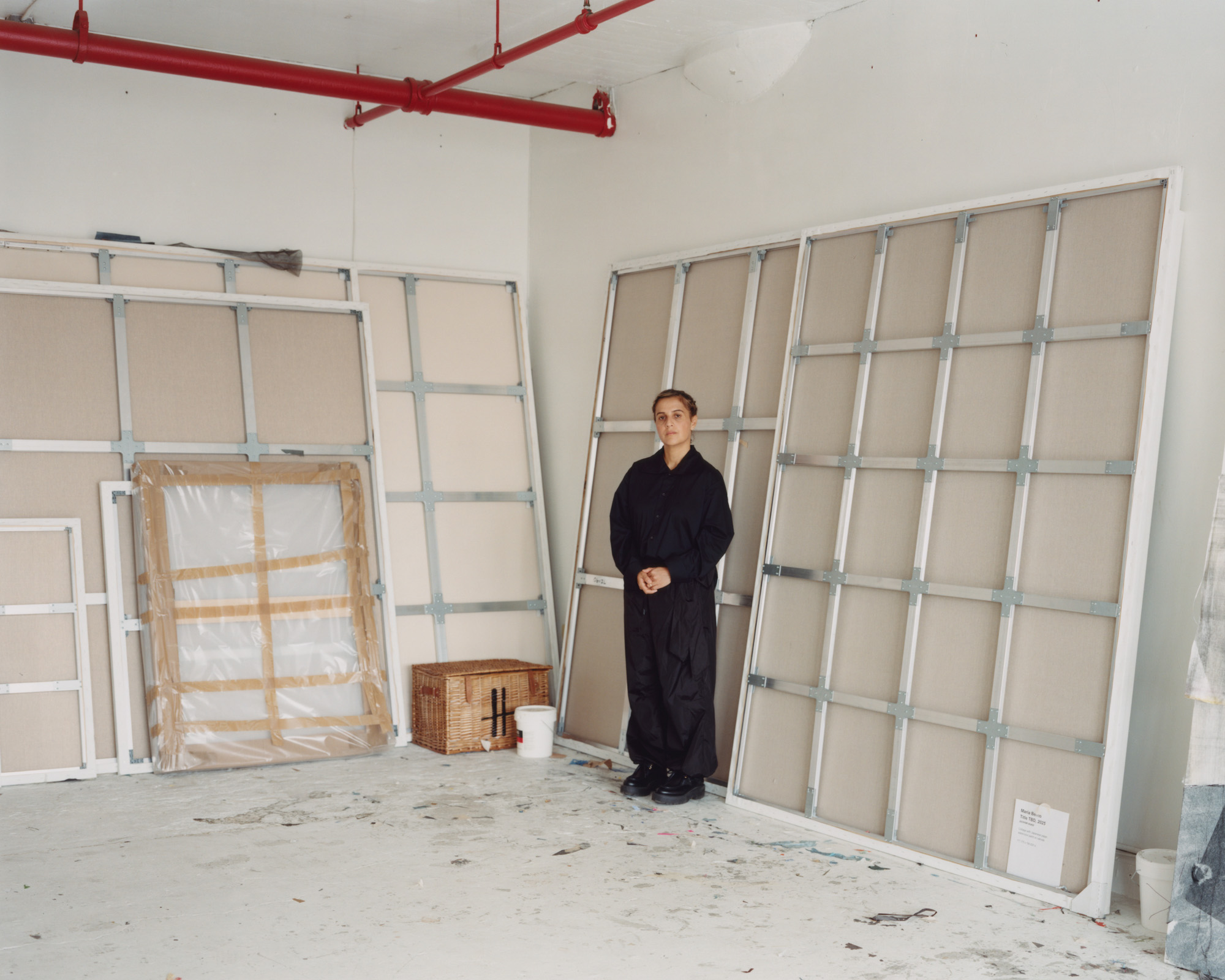‘I don't know what art is, but we have to make these things to understand ourselves’: Antony Gormley in New York
Wallpaper* meets Antony Gormley as his new exhibition, ‘Aerial’ opens at White Cube New York

‘People, for whatever reason, do associate me with the body - I think that's fair enough,’ says Antony Gormley when we catch up over Zoom, as he prepares to open his New York art exhibition ‘Aerial’ at the city’s White Cube. ‘But I am, and always have been, as interested in the body of the viewer as I am in mine, as an example of a human body in space.’
It is a preoccupation he is building on in ‘Aerial’ through sculpture, which references his earlier considerations of proprioceptive environments we have seen in the cave-like Room, the immersive Blind Light and in the Breathing Room drawings. ‘They are all attempts to somehow catalyse space itself and make environments in which the viewer’s body is invited to sense its own movement through time and space,’ Gormley adds. ‘And you could say that there are a number of works that do both. Take Model, Space Station, Cave – all of those are, as it were, buildings, but made with reference to the form of the body that you can actually enter and move through. And I'm continuing that line of thought.’

Antony Gormley,' AERIAL', is at White Cube New York 30 April – 15 June 2024
In Aerial the work – from which the White Cube show takes its title – solid aluminium bars create a lattice of dispersed energy into which the viewer is invited. The material’s lightweight qualities, making it a natural choice structurally, appealed to Gormley, as did its relationship to light. ‘These spines, elements, roots, branches – whatever we want to call them – are reaching out into space and trying to work in a way as a transmitter or a sensor. It's almost like a dowsing rod: as you walk, if there was a big truck coming down Madison Avenue, the whole thing would start to vibrate.’
Fittingly, New York, the antithesis of the open landscape Gormley has frequently interacted with in the past, is a key inspiration behind this work. He expresses his wonder at the high rise, high density of the city, of the sheer scale of human habitation in a small surface area. ‘I've always loved New York, because it seems to me the longest social experiment: can we live in ways that allow the maximum amount of human interaction, but at the same time acknowledge the nonhuman world and the elemental world.
‘New York remains, for me, this extraordinary place which has a very clear grid system, but it acknowledges early First Nation pathways that run through it and contradict the absolute grid system, down the cross streets and along the avenues. You feel the wind, you smell the sea view. The light in New York is extraordinary. There's a crispness and clarity. So in spite of it being an entirely human made environment, you're also aware of the elemental world.’

Antony Gormley is at ' AERIAL', White Cube New York 30 April – 15 June 2024
It recalls the restrained wildness of Piet Mondrian’s Pier and Ocean series. ‘This is really exciting,’ Gormley adds. ‘It is the biggest single challenge that our species faces. How are we going to reconcile our extended technology and our internal needs, with the rights and needs of the biosphere? Mondrian had to come to New York, it's the perfect place for doing what Mondrian began in, in the Pier and Ocean series, which was how do we apply a rational system of the understanding of basic structures to the natural world.’ The vastness and the density of New York provides a timely context. ‘I started in New York in 1984. This has always been, in a way, the testing ground for my proposals, and I think of every exhibition in a way as a proposition.’
Upstairs at White Cube New York, three cast iron Big Double Blockworks (all 2023) emotionally consider our essential need for human relationships. Made up of connecting stacks of blocks, in order to stay vertical, they are by necessity mutually interdependent, expressing both a vulnerability and a stability. ‘They are an expression of a feeling that I had: maybe this is something that everybody has experienced irrespective of Covid. That dwelling together and an acceptance of the intimacy of shared daily life. It was about recognising that another life became an extension of your consciousness. Sex is a very small part of it. What it is to do with is the idea that through intimate proximity, we extend our thought.’
Receive our daily digest of inspiration, escapism and design stories from around the world direct to your inbox.

Installation view of Antony Gormley ' AERIAL', White Cube New York 30 April – 15 June 2024
Big Tender comprises stacked body forms, while the upright bodies of Big Sidle and Big Bare express both a stability and precarity. ‘I would like to think my work invites empathy. It was through lockdown that I thought, I don't need to go through a meditation on the evolution of the works themselves. Why can't I just – and this is what we did – take two pre existing Blockworks and see how they might osmose or connect. And that was an incredible breakthrough. Now, I look back at the whole development of Blockworks over 12 years, and started kind of crashing them together. It was a total revelation. The two vertical [works] are the result of bringing together two previously made Blockworks and seeing how in order to stay standing, they had to share masses. The tectonics, or the sort of Jenga kind of discipline of that, became then the carrier of emotion. Where that load path passes, how one work depends upon the other and then becomes one thing in discovering a stable centre of gravity. And it was really, really, really exciting. It's new for me. And it's really exciting to show them here.’
By celebrating the feeling we all share when considering the instability of our world and climate, Gormley invites serious contemplation of our very human vulnerability. ‘I don't want sentimental pictures of people canoodling or whatever. But here is an invitation to think about this. I don't know what art is. I don't know what it can become. But it's an evolving story, as is the story of our species. And I do fundamentally believe that this is part of our toolbox for survival. We've had to make these things in order to understand ourselves.’
Antony Gormley 'AERIAL', is at White Cube New York until 15 June 2024

Antony Gormley ' AERIAL', is White Cube New York, 30 April – 15 June 2024
Hannah Silver is the Art, Culture, Watches & Jewellery Editor of Wallpaper*. Since joining in 2019, she has overseen offbeat art trends and conducted in-depth profiles, as well as writing and commissioning extensively across the worlds of culture and luxury. She enjoys travelling, visiting artists' studios and viewing exhibitions around the world, and has interviewed artists and designers including Maggi Hambling, William Kentridge, Jonathan Anderson, Chantal Joffe, Lubaina Himid, Tilda Swinton and Mickalene Thomas.
-
 A compact Scottish home is a 'sunny place,' nestled into its thriving orchard setting
A compact Scottish home is a 'sunny place,' nestled into its thriving orchard settingGrianan (Gaelic for 'sunny place') is a single-storey Scottish home by Cameron Webster Architects set in rural Stirlingshire
-
 7 colours that will define 2026, from rich gold to glacier blue
7 colours that will define 2026, from rich gold to glacier blueThese moody hues, versatile neutrals and vivid shades will shape the new year, according to trend forecasters
-
 In Norway, discover 1000 years of Queer expression in Islamic Art
In Norway, discover 1000 years of Queer expression in Islamic Art'Deviant Ornaments' at the National Museum of Norway examines the far-reaching history of Queer art
-
 Out of office: The Wallpaper* editors’ picks of the week
Out of office: The Wallpaper* editors’ picks of the week'Tis the season for eating and drinking, and the Wallpaper* team embraced it wholeheartedly this week. Elsewhere: the best spot in Milan for clothing repairs and outdoor swimming in December
-
 Out of office: The Wallpaper* editors’ picks of the week
Out of office: The Wallpaper* editors’ picks of the weekIt’s been a week of escapism: daydreams of Ghana sparked by lively local projects, glimpses of Tokyo on nostalgic film rolls, and a charming foray into the heart of Christmas as the festive season kicks off in earnest
-
 Inside the work of photographer Seydou Keïta, who captured portraits across West Africa
Inside the work of photographer Seydou Keïta, who captured portraits across West Africa‘Seydou Keïta: A Tactile Lens’, an exhibition at the Brooklyn Museum, New York, celebrates the 20th-century photographer
-
 Out of office: The Wallpaper* editors’ picks of the week
Out of office: The Wallpaper* editors’ picks of the weekFrom sumo wrestling to Singaporean fare, medieval manuscripts to magnetic exhibitions, the Wallpaper* team have traversed the length and breadth of culture in the capital this week
-
 María Berrío creates fantastical worlds from Japanese-paper collages in New York
María Berrío creates fantastical worlds from Japanese-paper collages in New YorkNew York-based Colombian artist María Berrío explores a love of folklore and myth in delicate and colourful works on paper
-
 Out of office: the Wallpaper* editors’ picks of the week
Out of office: the Wallpaper* editors’ picks of the weekAs we approach Frieze, our editors have been trawling the capital's galleries. Elsewhere: a 'Wineglass' marathon, a must-see film, and a visit to a science museum
-
 June Leaf’s New York survey captures a life in motion
June Leaf’s New York survey captures a life in motionJune Leaf made art in many forms for over seven decades, with an unstoppable energy and fierce appetite leading her to rationalise life in her own terms.
-
 Jamel Shabazz’s photographs are a love letter to Prospect Park
Jamel Shabazz’s photographs are a love letter to Prospect ParkIn a new book, ‘Prospect Park: Photographs of a Brooklyn Oasis, 1980 to 2025’, Jamel Shabazz discovers a warmer side of human nature